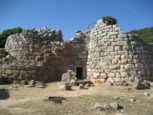Relax, fun, culture, sports and emotions: poker hand for Alghero and Capo Caccia

The entrance of the big bay of Porto Conte. In the background Capo Caccia
A holiday in Sardinia, at Alghero with “the Coral Riviera”, is fascinating and extraordinary in many ways. In fact, a period of relaxation in this area is enriched by cultural cues of considerable interest. In a part of the territory, which is not so big, stunning historical and archeological finds dating back to the Prenuragic and Nuragic ages are kept.
The Necropolis of Anghelu Ruju is the largest Prenuragic area in Sardinia. It was discovered by chance in 1903, during the excavations for the building of a farmhouse. The finding of some human bones encouraged further excavations, until crockery, jewels and several hypogean graves were discovered. Over the years, a total of 38 Domus de Janas (Home of the Fairies) were discovered,

The Palmavera nuraghe
along with underground graves dating back to three different historic periods: the civilization of Ozieri (3500 B.C.), of the bell-shaped vase (2000-1900 B.C.), and of Bonnanaro (1800 B.C.).
Don’t miss, nearby, the magnificent Nuragic complex of Palmavera. The main keep dates back to the Fifteenth-Fourteenth century B.C., and can be still visited in all its parts; including the large central room with a tholos cupola. Considered the structure of the complex, which was built at the foot of the Doglia Mountain, archaeologists presume that it was surrounded by cabins and refuges. The second cycle of life of the Nuraghe, started after the first half of the Ninth century B.C., when a second keep was added and the first one was covered with blocks of sandstone, a very common material in this area.
The visit is organized between the two towers, and it is also possible to visit the meeting cabin, where there are still a stone bench, a bath and the throne of the tribal chief. Several artifacts, found during the excavations, are mainly exhibited at the National Archaeological Museum “Sanna” in Sassari.
During a hiking tour in the nature Park of Porto Conte, or a snorkeling tour in the Marine Protected Area of Capo Caccia – Piana Island, is possible to see several coastal towers built during the Spanish domination. One of the most important is the tower of Tramariglio bay. It was made with chalky material at the end of the Sixteenth century. Today, it is still in good conditions, and from the inside, the dome vault and pillar on the terrace are visible, with the holes which allowed light to penetrate the structure.
A tour in Alghero and at Capo Caccia is not complete without a visit at the famous Neptune’s cave. It is one of the most stunning places easily reachable by visitors and was discovered by chance by a local fisherman in the Eighteenth century. It is accessible both by sea and by land, through the Escala del Cabirol (Stairs of Roebuck), with its 656 steps running along the cliff, and rising up from the sea, just in front of the Isola Foradada (Foradada Island).
- Anghelu Ruju Necropolis - Alghero
- The coast along the bay of Porto Conte and one of the Spanish towers
- Inside the Neptune's cave
- the Escala del Cabirol (Stairs of Roebuck)
- Dolphins at Capo Caccia
- Luigi Zagati's private scuba collection
- Capo Caccia, west coast, and the entrance to the Nereus cave
At Capo Caccia there’s also the famous Nereus Cave, the biggest and extended underwater cave in the Mediterranean sea that is possible to visit only by a diving escursion (expert and advanced level).
And for lovers of diving and snorkeling there is also the nice opportunity of the private museum of Luigi Zagati, witness of the pioneering age of diving at Capo Caccia.
A holiday in Alghero…, what a marvellous surprise!
Leave a comment
Other informations
Search
Category
Tag Cloud
Archive
Febbraio 2022 (1)
Gennaio 2018 (1)
Maggio 2016 (1)
Gennaio 2016 (1)
Giugno 2015 (1)
Marzo 2015 (1)
Febbraio 2015 (1)
Ottobre 2014 (1)
Maggio 2014 (1)
Gennaio 2014 (1)
Ottobre 2013 (1)
Giugno 2013 (1)
Aprile 2013 (1)
Marzo 2013 (1)
Dicembre 2012 (1)
Settembre 2012 (1)
Agosto 2012 (1)
Febbraio 2012 (1)
Gennaio 2012 (2)
Dicembre 2011 (3)
Novembre 2011 (2)
Archimete 2.0

Questo opera è distribuito con licenza Creative Commons Attribuzione - Non commerciale - Condividi allo stesso modo 3.0 Unported.












 RSS Blog
RSS Blog





